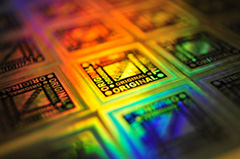Industry Predictions | TESTing Your Imagination
- Published: December 28, 2017, By Yolanda Simonsis, Editorial Director
Forward-thinking industry leaders submit their predictions for the gamut of converting topics, including counterfeiting, fluid & extrusion coating, recyclability, marketing, static control, adhesives, RFID, and web handling.
 Who doesn't like to hear they've passed a test…no matter the topic?
Who doesn't like to hear they've passed a test…no matter the topic?
With my last blog post on Yo's Yarns, I asked people to submit to me their projections for the future relating to the converting industry. Knowing how reluctant people are to associate their names with something concerning prognostication, I knew I was taking a chance on people submitting their predictions, so—just in case I was left empty-handed—I actually solicited some from contributors on PFFC's own expert advisory staff.
I tip my hat to these experts in thanks: Mark Miller (Coating Matters); Ingrid Brase (Sticking With It); Stephanie Millman (Marketing Mojo); Tim Walker (Web Lines); Tom Bezigian (Poly Ploys); Dr. Kelly Robinson (Static Beat); and Dr. Dene Taylor (On Print).
But I also have one other very brave submitter to thank: Manoj Kochar of the Intl. Hologram Mfrs. Assn., which celebrates is 25th anniversary in 2018. And because Kochar was bravest for being the first to submit predictions, his will be listed first. Following IHMA's predictions are those of PFFC's contributing experts, to whom I offer my sincere thanks.
YOUR further comments on these predictions are also welcome. Simply click on the Comments section at the bottom of this article, or feel free to send your comments directly to me at ysimonsis@pffc-online.com.
COUNTERFEITING
 Continued counterfeiting will drive hologram growth in 2018 but look out for new developments, says Manoj Kochar, including the following:
Continued counterfeiting will drive hologram growth in 2018 but look out for new developments, says Manoj Kochar, including the following:
- Global threats are set to continue to push demand for authentication and brand protection devices such as holograms. IHMA sees increased integration of holograms alongside other authentication and track and trace technologies to deliver overt and covert protection. This will only strengthen holography’s role in tax stamp programs in the next 12 months, combating the multi-billion global trade in illicit or counterfeit tobacco and alcohol products.
- While Europe and North America will continue to offer opportunity, it’s in the hot spots of Asia, where counterfeiting appears systemic, that offers massive commercial potential. Says Kochar: "Countries across Asia, notably India and China, will continue to offer unprecedented scope for growth for holograms in the battle to stem the tide of counterfeit goods flooding onto the market. “We will continue to see over the coming months increased integration of holograms in these territories as part of brand protection strategies being adopted by government and security agencies looking to tackle the problem.” Further, this will see the IHMA set to build on its work with the Chinese authorities to address the problems. Such moves will protect those retail brands destined for export markets against the threat of counterfeit criminals and organized crime.
- “Counterfeiting cannot be defeated in isolation, so collaboration with the likes of the IHMA will be paramount,” adds Manoj Kochar. “What we offer in terms of helping to tackle counterfeiting particularly with the use of the Hologram Image Register, has to be a welcome priority.
- International communication, open-mindedness, and closer collaboration will be beneficial as we move forward, helping IHMA to tackle and solve this problem with others.
- Added value authentication solutions, as advocated in ISO 12931, will enable examiners to verify the authenticity of a legitimate product, differentiating it from the counterfeits.
- Even those items that carry a ‘fake’ authentication feature can be distinguished from the genuine item if it carries a carefully thought-out authentication solution.
- The arrival of new banknotes in 2018, including a new Armenian series, new notes from Canada and Australia, and the new Swiss 200 Franc, will only strengthen holography’s central role as a cutting-edge security device.
- Holography will continue to hold up well in comparison with other optical variable features in the currency market and will endure for the foreseeable future.
- The use of polymer notes is growing and will benefit from holographic security features that will continue to reassure both central banks and the public about currency authenticity.
- Some of the holographic features in more traditional paper substrates will also continue to push the boundaries of what the technology can now achieve, demonstrating that there is plenty of mileage in holography yet.
- 2018 will also herald the Reserve Bank of India’s choice of selected products and providers for holographic security foils on banknotes, with approximate annual volumes of eight billion units.
- Holograms for ID, where innovations linked to digital applications, packaging and tax stamps, are all tipped for continued growth.
- “We have seen holographic features on ID documents grow hugely over the last few years, and there’s now a suite of products that incorporate ‘opto-digital’ functionality,” says Manoj Kochar.
 As eye-catching holograms add design appeal to brand packaging, expect to see in 2018 extended success in a sector where companies have to invest in new products or refresh existing brands to meet consumer demand.
As eye-catching holograms add design appeal to brand packaging, expect to see in 2018 extended success in a sector where companies have to invest in new products or refresh existing brands to meet consumer demand.
- The IHMA also predicts more activity for holographic optical elements (HOE), which represents an exciting area of opportunity for holography.
- Organizations will explore holography technologies for new wearable head-up displays and other smart devices to enhance people’s lives, says Kochar: “While we have seen some fantastic industrial uses of this technology, we are yet to see significant consumer adoption, mainly due to price. Will 2018 be the year that changes this?”
- With LEDs in use as vehicle rear lights and brake lights, HOEs are being used to enhance the emitted light while they also have an important role in vehicle instrumentation and improving the image on small and large format LCD and OLED displays.
- The application of holography in solar energy harvesting could also be an area to watch in the coming years as holographic mass production technology gains traction, which will help to decrease the cost of solar panels and improve efficiency.
- “Display holograms, which are often overlooked and a small sector within the holographic market also possess growth potential, so 2018 could well see activity in this sector starting to gain some traction,” concludes Manoj Kochar.
Mark Miller of "Coating Matters"
 Bold predictions for the fluid coating industry include the following:
Bold predictions for the fluid coating industry include the following:
- Trends for coating thinner and faster and cleaner will continue leading to more data collection and analysis surrounding each of the six steps of the converting process:
• Controls = computer integration and control of the overall process
• Continuous = web handling (speed and tension control)
• Compounding = rheology, mixing, pumping, filtering and flow control
• Coating = fluid deposition for active ingredients and primers
• Curing = ovens, UV and E-beam curing (heat, light and energy)
• Converting = laminating, slitting and rewinding
- Energy storage (battery, solar and fuel cell), optical and electronics coatings will dominate the leaders in technology. This is because of need for differentiation and cost improvements on an annual basis.
For thorough coverage of what the future holds for fluid coating technology, visit this URL and listen to this podcast: www.slotdie.com
Ingrid Brase of "Sticking With It"
 There is the continual pressure to be more environmentally responsible. This will push the converter industry towards developing programs to recycle liner and develop adhesives that are recycle-friendly and eventually, recyclable.
There is the continual pressure to be more environmentally responsible. This will push the converter industry towards developing programs to recycle liner and develop adhesives that are recycle-friendly and eventually, recyclable.
Stephanie Millman of "Marketing Mojo"
 Acquisitions and targeted organic growth strategies will continue to rise as there is and will continue to be a lot of cash available in the industry.
Acquisitions and targeted organic growth strategies will continue to rise as there is and will continue to be a lot of cash available in the industry.
- The government strategies of building infrastructure, bringing more manufacturing to the States, possible repatriation and tax cuts for business, expanding military as well as the need for construction materials to rebuild the damage from the 2017 storms will provide a great deal of opportunity for money flow in the States.
- Eastern Europe, China, and India will continue to grow strong.
- Businesses will need to make commitments to investment in technology leveraging the Internet of Things, Artificial Intelligence, robotics, and autonomous processes as well as in talent to be able to execute go-to-market strategies.
- Marketing communications efforts will continue to struggle to find the “high touch” connection with prospects and customers as their products and organizations become more “high tech.” When an organization's leadership embraces the marriage between technology and personalization (customer touchpoint), then the transition to our new marketing communications era will be successful. Until then, social media and marketing communications runs the risk of being perceived as an afterthought and sometimes “disconnected.”
Tim Walker of "Web Lines"
 Looking strategically at the next 10 years, converters will experience the following:
Looking strategically at the next 10 years, converters will experience the following:
- Some products will continue strong domestic manufacturing, as they are either too light (tissue & toweling) or too heavy (roofing shingles) to be shipped in from overseas.
- More converting processes will be surrounded by cages or walls to keep employees away from the hazards of moving webs and rollers. Even though this makes it more difficult to get close enough to troubleshoot some problems, safety wins out over process optimization.
- Engineering, especially controls/electrical engineering talent will continue to be in short supply as those with programming aptitude will be drawn to internet, gaming, and mobile app industries.
- Recycling will continue to expand, even when economic models or environmental concerns may not justify it in all locations.
- Converters should invest in the following growth areas:
• Battery technology, as we carry (and are carried by) more and more mobile electronics devices.
• Water saving and purifying technology, another outcome of the precious water market.
• Shipping-related packaging. Amazon-Prime and similar services will only expand.
Tom Bezigian of "Poly Ploys"
 While I don't like to predict the future, I'll go out on a limb this time…
While I don't like to predict the future, I'll go out on a limb this time…
- There will be no organized growth in the extrusion segment…just upgrading or replacement of old, inefficient equipment.
- People have learned that extrusion coating and laminating is most efficient on long runs (like for potato chipbag and balloon film), and it's terrible on short runs (life for everything else).
- More adhesive laminators will come on line versus extrusion laminators.
- Almost everything is a commodity now, so prices will drop.
Dr. Kelly Robinson of "Static Beat"
 Lower static levels will be required on printing and converting lines:
Lower static levels will be required on printing and converting lines:
- Electronic functionality designed into packaging such as RFID tags requires improved static control.
- Chemical functionality incorporated into packaging such as moisture/ oxygen penetration indicators may be damaged by static sparks.
- Suppressing static sparks from the beginning to the end of printing and converting lines will become more important:
• Label and flexible package volumes will grow.
• Static sparks anywhere in printing and converting can cause label stacks to block.
• Static sparks anywhere in printing and converting can cause bag opening failures.
• Suppressing static sparking addresses the root causes of these static problems.
- “Pre-engineered” static control systems will become more available:
• Today’s static control systems are custom designed by printing/converting employees, vendors and consultants.
• “Best practice” static control will standardize static control systems.
Dr. Dene Taylor of "On Print"
 As a member of RAIN Alliance—the association for passive ultra high frequency radio frequency identification (UHF RFID), which is used for such toll collections as EZ Pass, etc.—we have set the following future goals:
As a member of RAIN Alliance—the association for passive ultra high frequency radio frequency identification (UHF RFID), which is used for such toll collections as EZ Pass, etc.—we have set the following future goals:
- To have RAIN RFID commonly integrated into individual retail packaging in 5 years.
- While retail clothing is the model, RAIN (passive) RFID will be widely integrated into individual retail flexible and folding carton packaging in 5 years.
Now it's YOUR turn. If you have any predictions you wish to share, send them to me at ysimonsis@pffc-online.com and get noticed as a leader among your peers in the converting industry!












